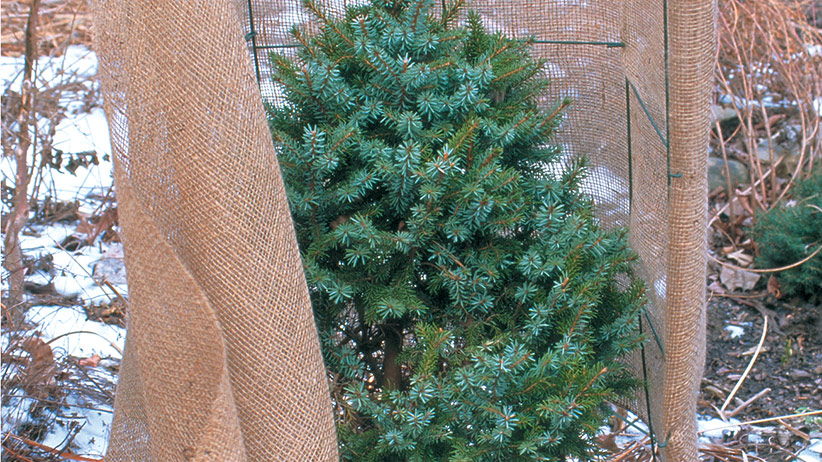
Grow these host plants to support different types of butterflies
Butterflies are beautiful and fascinating creatures with scales on their wings and “taste buds” on their feet. But populations have been declining, partly due to habitat loss. The good news is that gardeners can help! If you grow the host plants that specific butterflies love, you can support them through the entire life cycle. Host plants are where butterflies choose to lay eggs, which hatch into caterpillars that feed there until they form chrysalises and undergo metamorphosis.
Perfect plants for butterflies
How do female butterflies know which plant to lay eggs on? They have special taste organs on their forelegs and feet to help determine if a plant, such as the black-eyed Susan above, is what they’re looking for. Some species lay single eggs; others lay in clusters, usually on the underside or top of a leaf. Newly hatched caterpillars are little eating machines that typically have four to five stages of growth, or instars, over several weeks before forming a chrysalis.
What do caterpillars eat?
Foliage is the most popular item on the menu, but some caterpillars also eat flowers. Some species are very specific about which plants are best for their young — for example, monarchs only eat milkweeds. Others aren’t picky at all. Painted lady larvae have been found feeding on 100 different plants, such as thistles, hollyhock and members of the pea family.
Besides growing host plants, the best thing you can do to help butterflies is to avoid using pesticides and herbicides (even organic solutions, such as neem oil or pyrethroids). They’re just as deadly to butterflies and their young as they are to insect pests.
If you’re wondering which butterflies might be stopping by the garden, ask your county extension agency or visit butterfliesandmoths.org/. Now let’s take a look at a few host plants for some common North American butterflies.
You Might Also Like:
Butterfly & Caterpillar Illustrated Poster
How to Identify Common Butterflies
Butterfly Garden Planting Plan
How to Establish a Monarch Waystation
Butterfly host plants to add to your garden

Black-eyed Susan (Rudbeckia fulgida)
Host plant for: checkerspot and malachite butterfly
There’s a lot to love about black-eyed Susans. This resilient native wildflower is drought tolerant and deer resistant, and tolerates clay soil. Plants flower best in full sun, and deadheading helps encourage additional blooms. Cultivars, such as the popular ‘Goldsturm’, are more likely to be found in garden centers than the species.

Black-eyed Susan is also a host plant for the wide-ranging silvery checkerspot and the malachite butterfly, which are found in the southern United States, mostly in Florida and Texas. They both eat the leaves of black-eyed Susan. Look closely and you may find the malachite’s prickly black-and-red larva taking a rest on the underside of a leaf.
Type: Perennial
Blooms: Single golden-yellow blooms with a brown center from summer to fall
Light: Full sun
Soil: Average, well-drained
Size: 2 to 3 ft. tall, 1 to 2 ft. wide
Cold hardy: USDA zones 3 to 9
Source: Local garden centers

Purple prairie clover (Dalea purpurea)
Host plant for: dogface, striped, Reakirt’s blue and Mexican blue butterflies
Purple prairie clover is an easy-care native perennial found across much of North America. It grows best in full sun and well-drained soil but tolerates sandy and clay soil too. New plants are slow to take off because they’re busy forming a long taproot, which can grow up to 6 feet deep. Because of this, purple prairie clover doesn’t like to be moved once it gets established, but the taproot does make plants super drought- and heat-tolerant.
Small thimblelike cones covered with tiny individual flowers arrive in summer and keep going to early fall. They’re a magnet for all kinds of bees and butterflies. At the same time (and depending on the region), southern and California dogface butterflies will be making a meal of the foliage. Striped, Reakirt’s and Mexican blue caterpillars eat the leaves and nibble the flowers.
You’ll find plants for sale, but seeds are a more economical solution if you have a large space to fill. Direct sow or start them indoors four to six weeks before your last frost date. Seedlings should emerge in 10 to 12 days and can go outdoors when nighttime temperatures are consistently above 50 degrees F.
Did you know?
You may notice ants hanging around the Reakirt’s blue caterpillars that are eating your purple prairie clover — they have a symbiotic relationship. The caterpillars release a pheromone to attract the ants, then secrete a sweet solution to keep them around and help protect against parasitic wasps and flies.
Type: Perennial
Blooms: Tiny rose-purple flowers open on stubby gray-green cones from early summer to early
fall
Light: Full sun
Soil: Well-drained
Size: 12 to 36 in. tall, 12 to 18 in. wide
Cold hardy: USDA zones 3 to 8
Source: Prairie Moon Nursery (plants and seeds)

Hollyhock (Alcea rosea)
Host plant for: painted lady and common checkered skipper butterflies
Tall or short, single or double, upright hollyhocks add interest and excitement to any sunny border or container. Long stems are covered with saucer-shaped blooms in about every color but blue. Hollyhocks are a cottage garden favorite that hosts the larvae of painted lady and common checkered skipper butterflies. If you notice a silky covering on top of a hollyhock leaf with a spiny dark brown to black caterpillar inside, that’s a painted lady. Common checkered skipper caterpillars are green with a brown head and fold leaves around themselves as they eat.

Technically, hollyhocks are biennial, growing just a mound of foliage the first year and flowering the second. While some older varieties follow this pattern, many of the newer series, such as Spotlight or Halo above, bloom the first year from seed. The key is to start hollyhock seeds early indoors — 6 to 8 weeks before your last frost date. When seedlings are 3 to 4 inches tall, they can go outdoors for the season.
Type: Biennial
Blooms: Pink, white, black, peach, yellow, red or burgundy in summer
Light: Full sun to part shade
Soil: Well-drained
Size: 3 to 8 ft. tall, 1 to 2 ft. wide
Cold hardy: USDA zones 2 to 10
Source: Swallowtail Garden Seeds

Butterfly weed (Asclepias tuberosa)
Host plant for: monarch butterflies
Most animals won’t eat butterfly weed — it tastes bad and can make them sick. But monarchs love to lay their eggs on this boldly colored perennial. After hatching, the caterpillars eat the leaves and sometimes the flowers, even though the plant is filled with toxins to most creatures. The caterpillar’s body is able to store the poison to ward off predators.
While there are lots of different milkweed species in a range of sizes and flower types, butterfly weed (above) has the brightest blooms, doesn’t spread as aggressively as some of the others and doesn’t have the milky white sap when you break a stem.

You can buy butterfly weed plants at the garden center or direct sow seeds. Fall is the best time to do this because seeds need stratification, or a period of cold temperatures, for the best germination. You can mimic this process by keeping seed packets in the refrigerator for 2 to 3 months before planting. Give butterfly weed full sun and well-drained soil.
Good to know
The Xerces Society can help you find a seed source in your area. Visit their Milkweed Seed Finder here for more information.
Type: Perennial
Blooms: Clusters of bright orange blooms from early summer to fall
Light: Full sun
Soil: Dry, well-drained
Size: 12 to 30 in. tall, 12 to 18 in. wide
Cold hardy: USDA zones 3 to 9
Sources: High Country Garden, Prairie Moon Nursery, Prairie Nursery

Snapdragon (Antirrhinum majus)
Host plant for: common buckeye butterflies
Though common buckeyes migrate north in late spring to summer, this butterfly is a year-round resident in the southern United States and along the coasts of California. So having a steady supply of cool-weather-loving snapdragons in the garden will ensure the caterpillars have plenty of leaves to snack on.

Find snapdragons in a range of colors and sizes
Snapdragon’s unique blooms come in a wide range of colors that you can use to create gorgeous early-season bouquets. There’s also a range of sizes that will keep borders filled with color from front to back. Edge the garden with the 6-inch-tall Candy Showers series and keep midborders bright with ‘Rocket Orchid’ above, which grows 3 feet tall. At the back of the border grow Potomac series, which can reach 5 feet.
Cool weather is when snapdragons are at their best. Once nighttime temperatures reach 70 degrees F regularly, plants slow down and can look a bit ragged. You can cut them back and keep watering to get more blooms in fall. Or pull the plants and replace them with warm-weather lovers.
Type: Tender perennial (usually grown as an annual)
Blooms: White, yellow, red, orange, pink, purple and peach from spring to frost
Light: Full sun
Soil: Moist, well-drained
Size: 4 to 36 in. tall, 6 to 24 in. wide
Cold hardy: USDA zones 7 to 10
Source: Johnny’s Selected Seeds

Parsley (Petroselinum crispum)
When your parsley patch goes from lush, beautiful growth to ragged, leafless stems, it could mean that swallowtail caterpillars have turned it into their personal buffet line. There are 30 species in North America. Two of the most common are the black swallowtail, which is mostly black with a band of yellow spots on the lower portion of the wing, and the Eastern tiger swallowtail, which is mostly yellow with black markings. Eastern swallowtail larvae will often spin a mat of silk on top of the leaf to feed from.
Two types of parsley
There are two common types of parsley: curly- or flat-leaf (also called Italian). Both are biennial and are often grown as an annual. Plants produce lush foliage the first year and send up yellow spring flowers the next. Parsley leaves aren’t as flavorful after flowering (the caterpillars won’t mind). But if you let the blooms dry in place, they’ll reseed, providing you with more plants the following year.
Did you know?
Mature swallowtail caterpillars stop feeding on parsley late in the season and search for a dry stem or leaf on which to form chrysalises. The last generation hibernates through winter and emerges in spring.
Type: Biennial
Blooms: Yellow flowers in spring
Light: Full sun to part shade
Soil: Moist, well drained
Size: 12 to 18 in. tall, 9 to 12 in. wide
Cold hardy: USDA zones 4 to 11
Source: Local garden centers
You Might Also Like:
Easy Ways to Preserve Fresh Garden Herbs
How to Avoid Basil Downy Mildew
Natural Housekeeping Ideas With Garden Herbs

Sundial lupine (Lupinus perennis)
Host plant for: endangered Karner blue butterfly
These elegant spires will turn heads from late spring to early summer. Sundial lupine blooms in shades of lavender to blue, white and on the rare occasion, pink, and stems grow up to 2 feet tall. Once the blooms fade, they form 2-inch-long seedpods that look like fuzzy beans. Plants will reseed and spread by rhizomes where they’re happy.
Plants are generally trouble-free and easy to care for as long as they have well-drained to sandy soil. Too much clay, and this perennial will rot.
Sundial lupine is the only larval host for the endangered Karner blue butterfly found in scattered locations from eastern Minnesota to New Hampshire and New York. Eggs hatch in April to early May from overwintered eggs. Caterpillars eat the leaves and flowers, growing quickly to form chrysalises in 3 to 4 weeks. In July the second generation lays eggs in lupine seedpods or on stems near the ground, where they will overwinter.
Type: Perennial
Blooms: Spires of pealike lavender or blue and white flowers in late spring to early summer
Light: Full sun to part shade
Soil: Dry, sandy, well-drained
Size: 12 to 24 in. tall, 12 to 18 in. wide
Cold hardy: USDA zones 3 to 8
Source: Prairie Nursery (plants and seeds)

Blue grama grass (Bouteloua gracilis)
Host plant for: Uncas and Rhesus skippers, Garita skipperling, Ridings’ satyr butterflies
Did you know that even ornamental grasses can be a host plant for butterflies? Blue grama grass is a favorite of the Uncas and Rhesus skippers as well as Garita skipperling and Ridings’ satyr butterflies. All of these caterpillars eat leaves. Uncas skipper even creates a little nest of foliage so it can eat in comfort, out of any hungry predator’s sight.
While this drought-tolerant grass is native to the Great Plains and Southwestern United States, it makes a great garden plant across much of North America, and has even been used as a lawn replacement. Its small size means blue grama grass works well near the front of the border, where the slender blue-green foliage provides plenty of texture and tan horizontal flowers bob in the breeze. By fall, plants mature to golden brown and stay standing for most of winter.
‘Blonde Ambition’ above is popular cultivar that looks like the species but has chartreuse flowers that age to lighter tan. It’s larger than the species too, growing 2 to 3 feet tall and wide. Blue grama grass forms broad clumps and makes a polite border companion with lots of other sun-loving perennials. This easygoing grass tolerates a wide range of soils except poorly drained ones, which could cause it to rot. Where plants are happy, they’ll even self-seed.
Type: Perennial
Blooms: Tan horizontal flowers in summer to fall
Light: Full sun to part shade
Soil: Dry to moist, well-drained
Size: 12 to 24 in. tall, 18 to 24 in. wide
Cold hardy: USDA zones 3 to 10
Source: High Country Gardens (plants)

Purple passionflower (Passiflora incarnata)
Host plant for: zebra heliconian, gulf and variegated fritillaries
The amazingly ornamental 2½-inch blooms of purple passionflower are easier to grow than you might think. This native vine flowers best in full sun to part shade in well-drained soil. Plants are drought tolerant once established. An inch or two of organic mulch helps conserve water and keep roots cool.
Purple passionflower is the hardiest of this genus, and while you can grow it in USDA zone 5, it’s not always reliable. To keep it coming back in cold winter areas, provide a protected spot in the garden or plant it in a container so you can move it into the garage after freezing temperatures kill the foliage.
![]()
Keep an eye on the vines, and you may notice the caterpillars of gulf or variegated fritillaries lumbering along its slender stems looking for the next leaf or flower to nibble. Zebra heliconian larva eat the foliage, but to see one, you might need a flashlight — these caterpillars come out at night.
Type: Vine
Blooms: Fragrant white flowers with an ornate purple crown, or center, in summer
Light: Full sun to part shade
Soil: Well-drained
Size: 6 to 8 ft. tall, 3 to 6 ft. wide
Cold hardy: USDA zones 5 to 9
Source: Logees (plants)















